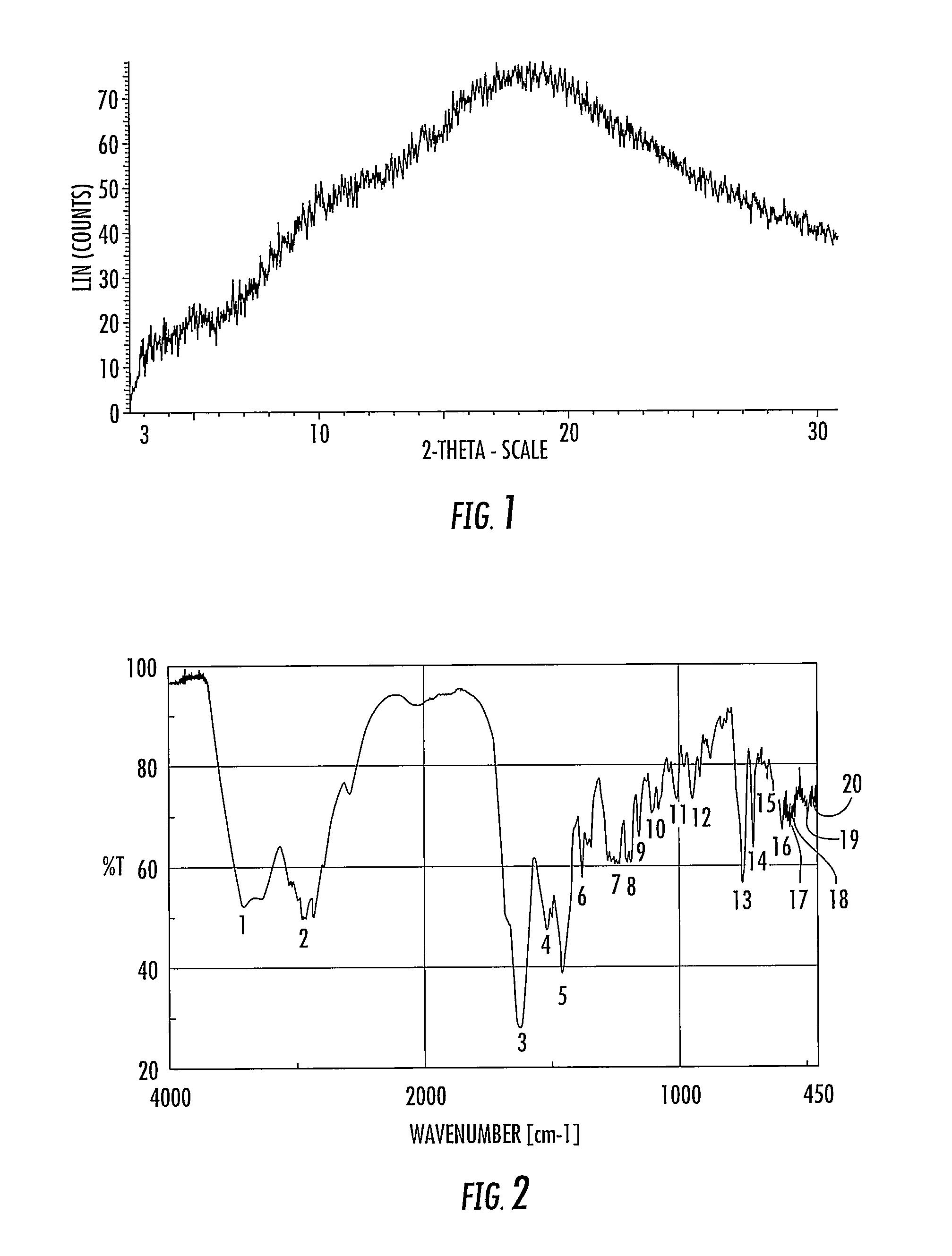Methods of producing anamorelin hydrochloride having controlled chloride content
a technology of anamorelin hydrochloride and chloride content, which is applied in the field of anamorelin hydrochloride, can solve the problems of reduced solubility of molecule, high chloride content, and long-term instability of final product, and achieve excellent solvent reduction, stable amorphous form, and reduce the production of anamorelin dihydrochloride
- Summary
- Abstract
- Description
- Claims
- Application Information
AI Technical Summary
Benefits of technology
Problems solved by technology
Method used
Image
Examples
example 1
Preparation of Anamorelin Hydrochloride
[0100]Various methods have been developed to prepare the hydrochloric acid salt of anamorelin, with differing results.
[0101]In a first method, which is the preferred method of the present invention, anamorelin free base was carefully measured and dissolved in isopropyl acetate. Anamorelin free base was prepared according to known method (e.g., U.S. Pat. No. 6,576,648). A fixed volume of HCl in water containing various molar ratios (0.80, 0.95, 1.00 or 1.05) of HCl relative to the anamorelin free base was then combined with the anamorelin / isopropyl acetate solution, to form a mixture having an organic and an aqueous phase. The aqueous phase of the mixture was separated from the organic phase and the resulting aqueous phase was concentrated by spray drying to obtain the batches of anamorelin monohydrochloride (or a composition comprising anamorelin monohydrochloride) shown in Table 1A.
[0102]Approximately 150 mg of the resulting spray dried sample...
example 2
Spray Dry Methods
[0114]Several spray dry methods have been developed by varying the type of nozzle, the conditions at the nozzle, the inlet and outlet temperatures, the temperature of the condenser, and the feed rate. The amount of anamorelin monohydrochloride (or composition comprising anamorelin monohydrochloride) produced, the yield of each process and representative process parameters according to the present invention using Niro QSD-3.6 (trade mark, GEA process engineering Inc.) are reported in Table 2A.
[0115]
TABLE 2ACo-current nozzleAmountFlow TT TFeed of Ø[kg / h] / P inletoutletcondenserrateproductBatch[mm][bar][° C.][° C.][° C.][kg / h][kg]Yield122519095213.56.1592.5%1.6A2251909522549.8594.6%1.5B22519095225130.498.6%1.6Rotary nozzleAmountPFlowT T T Feed of Batch[bar][kg / h]inletoutletcondenserrateproductYield23.310.119095213.56.1298.5%34.413.619095213.55.9799.2%45.015.619095213.56.3997.8%
[0116]Various physical properties of the anamorelin monohydrochloride (or composition comprisi...
example 3
Stability Testing
[0122]The stability of anamorelin monohydrochloride (or composition comprising anamorelin monohydrochloride) prepared according to the foregoing examples was evaluated at 25° C. / 75% relative humidity and 40° C. / 75% relative humidity for one, three and six months. The purity of the anamorelin monohydrochloride (or composition comprising anamorelin monohydrochloride) was measured using high performance liquid chromatograph (HPLC) (Hewlett-Packard HP 1100 HPLC System, Agilent Technologies Inc.). The concentrated aqueous solution of anamorelin monohydrochloride A of example 1 was concentrated by spray drying using Niro QSD-3.6 (trade mark, GEA process engineering Inc.) to afford anamorelin monohydrochloride referred to as Batch A in Tables 2A and 2B) in an amorphous state. The resulting amorphous product was dissolved in acetonitrile:water (1:1) and measured under the conditions reported in Table 3A. The results are presented below in Table 3B. RRT refers to the relativ...
PUM
 Login to View More
Login to View More Abstract
Description
Claims
Application Information
 Login to View More
Login to View More - R&D
- Intellectual Property
- Life Sciences
- Materials
- Tech Scout
- Unparalleled Data Quality
- Higher Quality Content
- 60% Fewer Hallucinations
Browse by: Latest US Patents, China's latest patents, Technical Efficacy Thesaurus, Application Domain, Technology Topic, Popular Technical Reports.
© 2025 PatSnap. All rights reserved.Legal|Privacy policy|Modern Slavery Act Transparency Statement|Sitemap|About US| Contact US: help@patsnap.com


